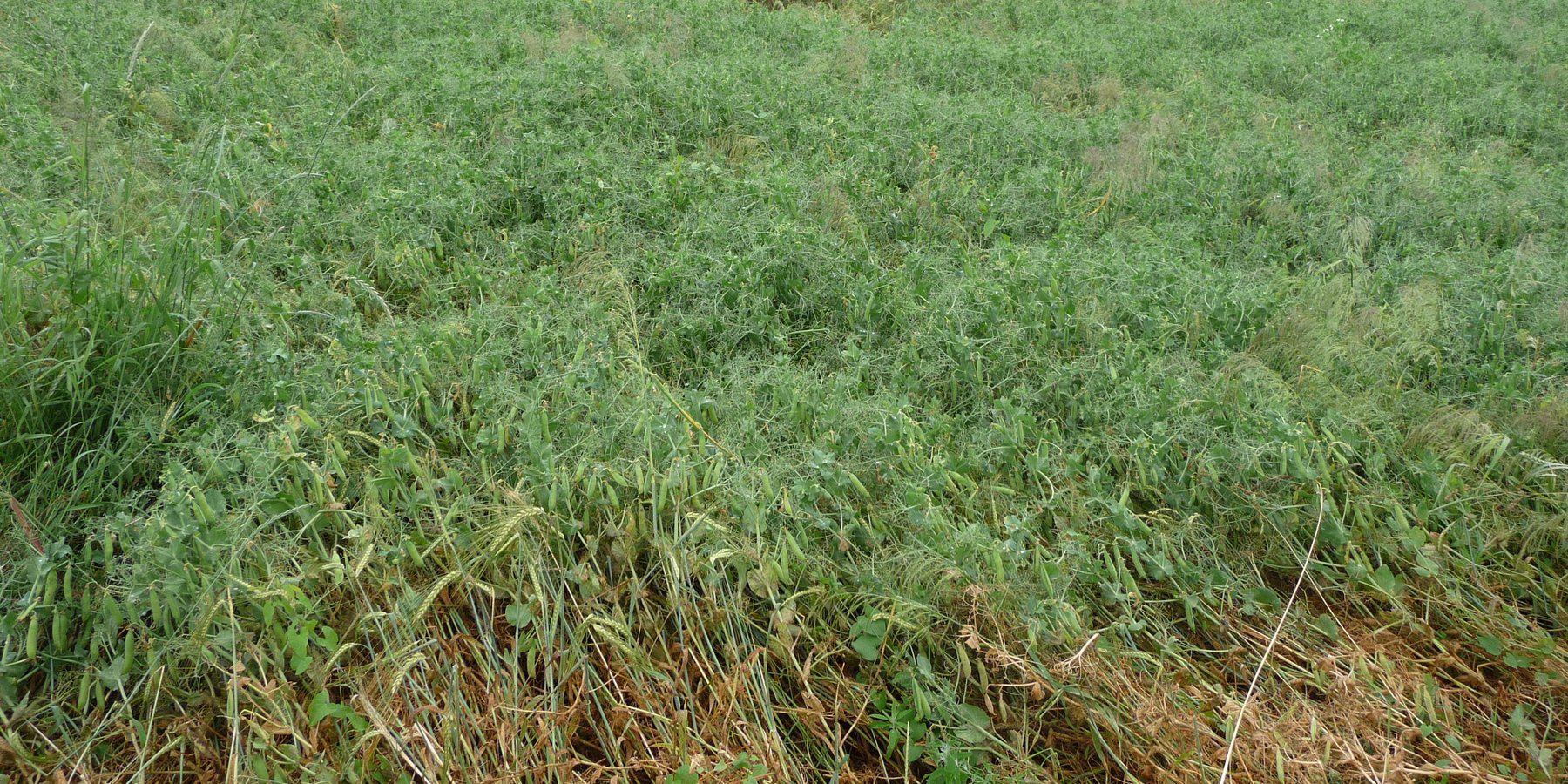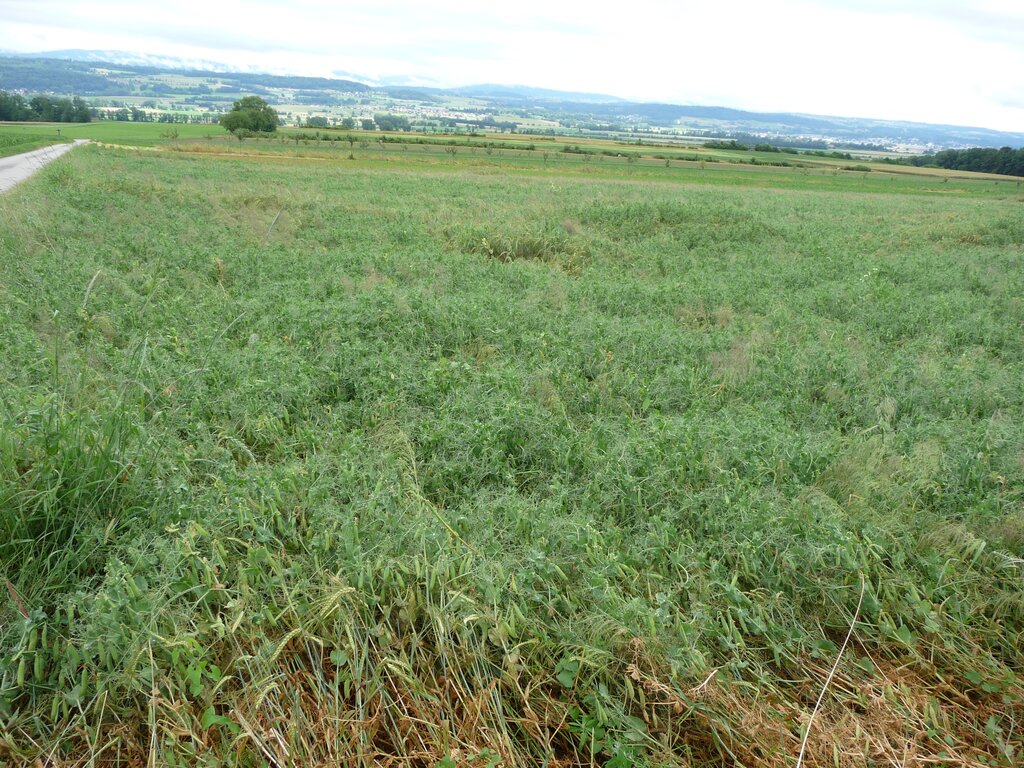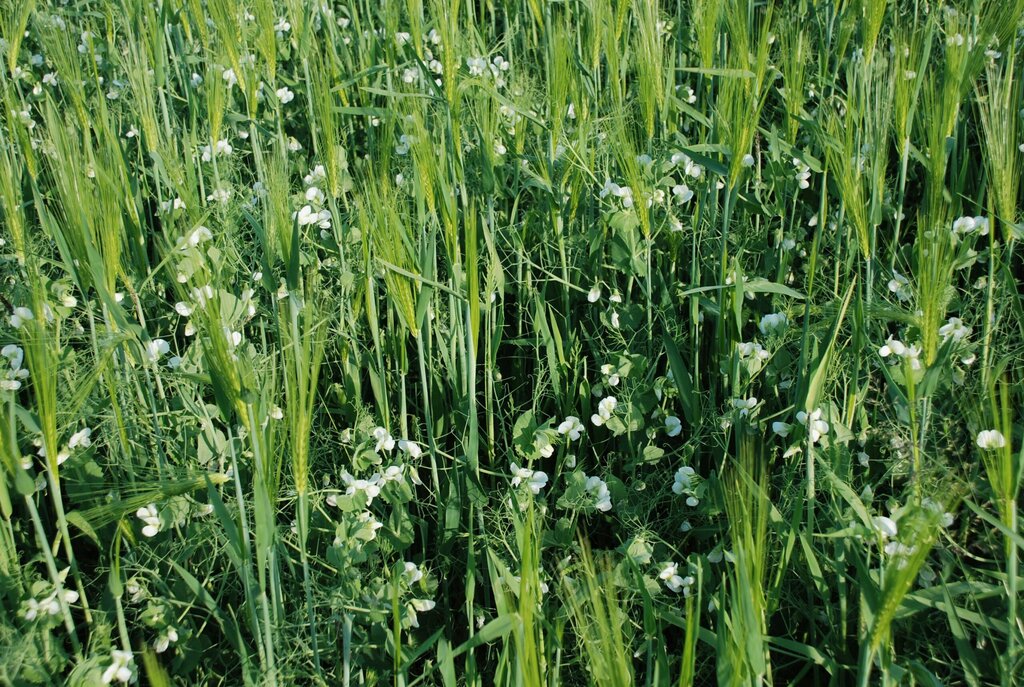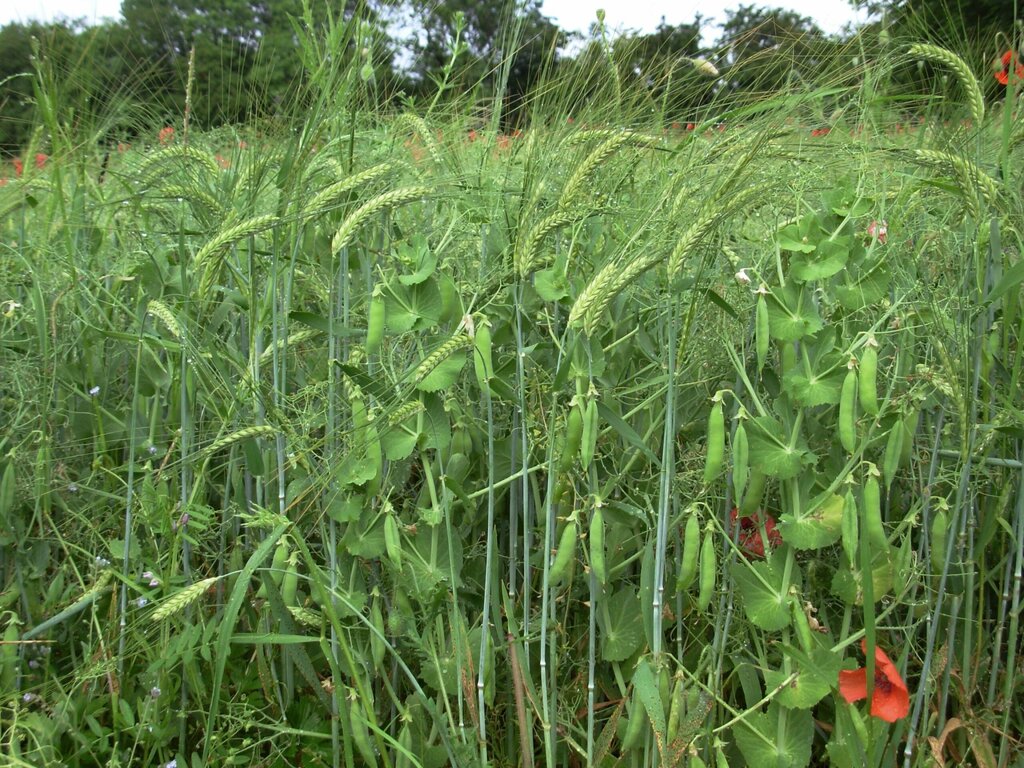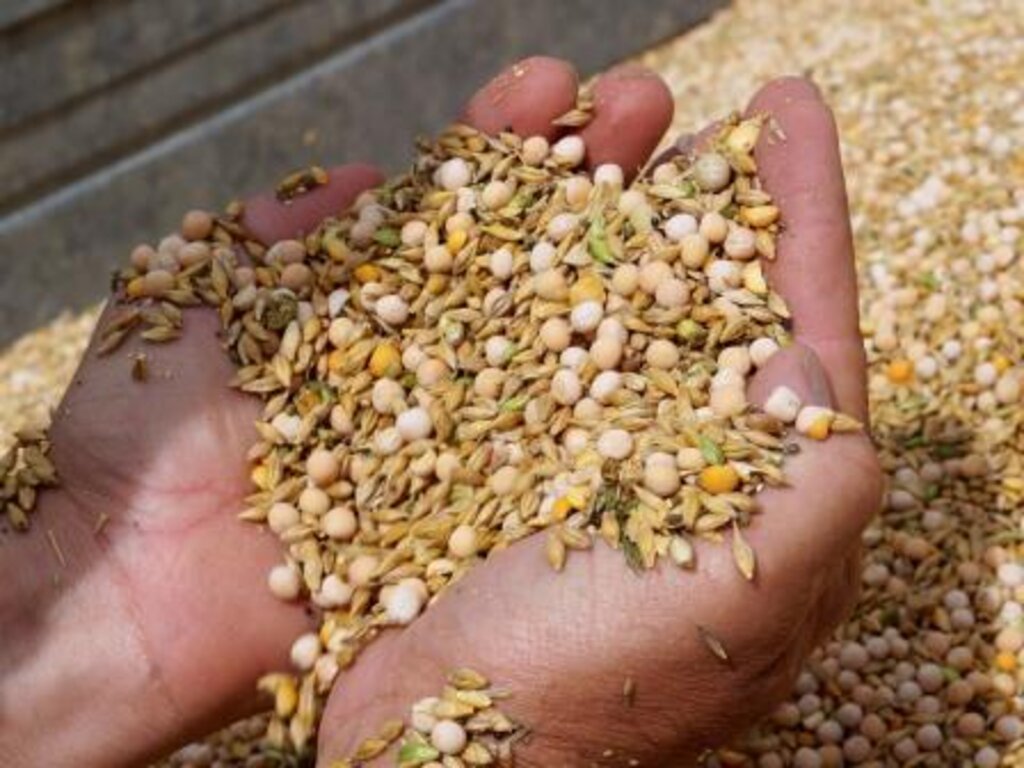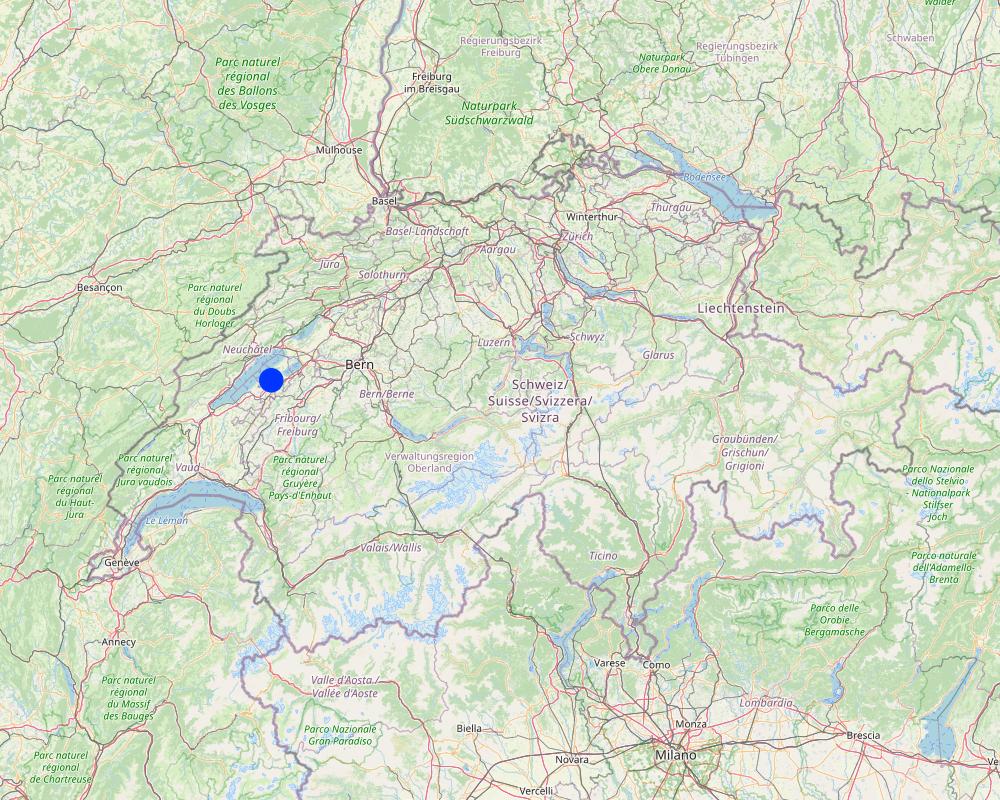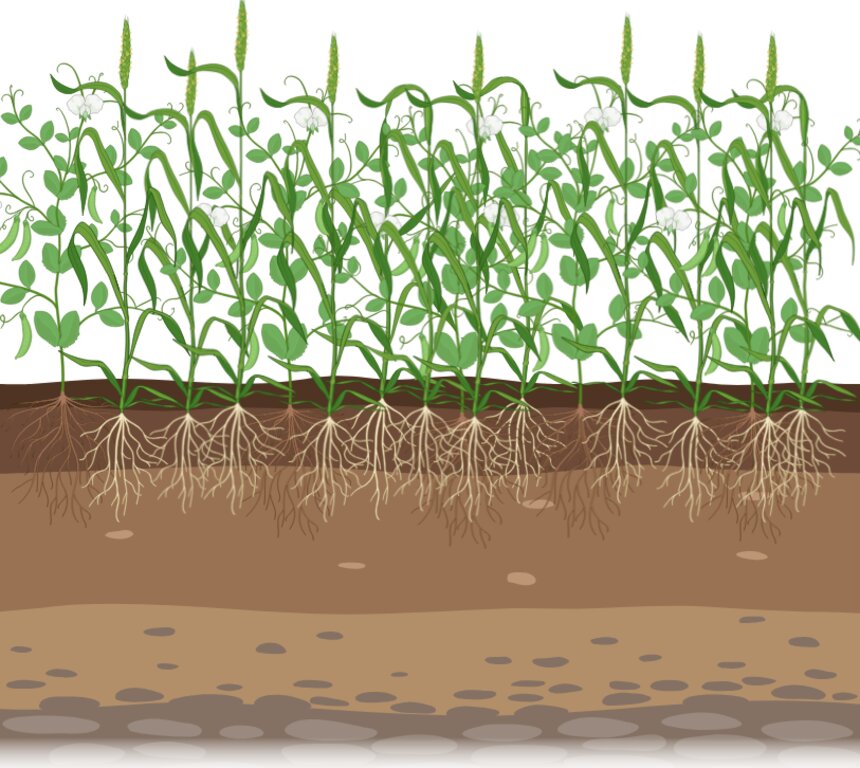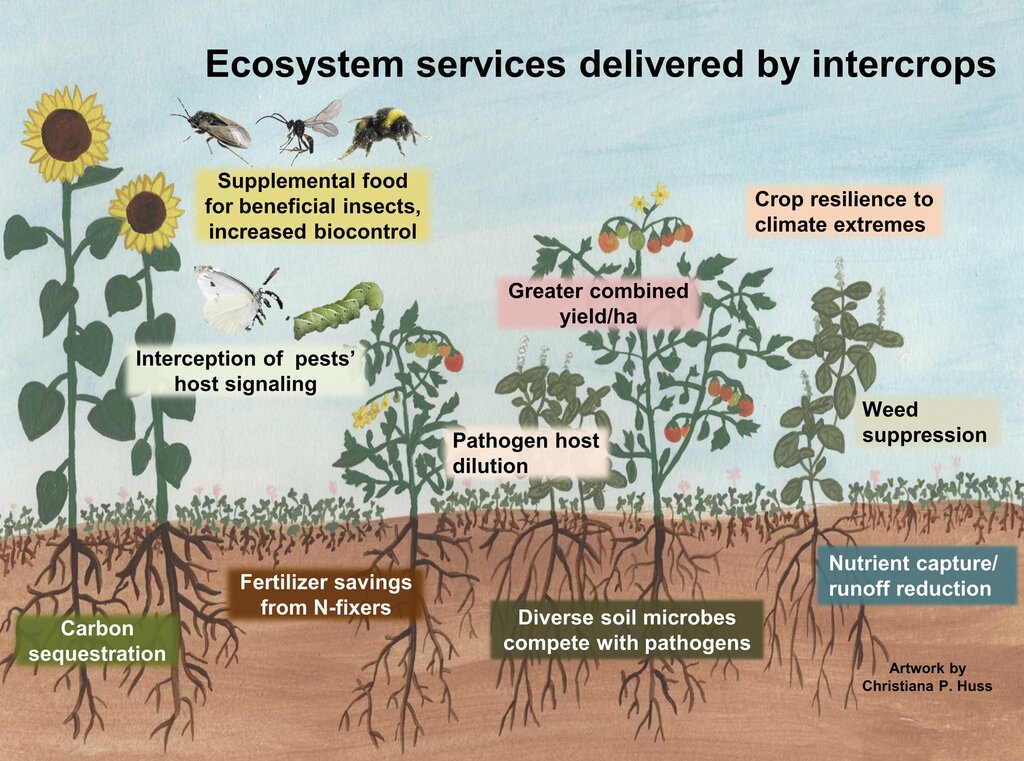Intercropping of grain legumes with cereals [Швейцар]
- Шинийг нээх:
- Шинэчлэх:
- Эмхэтгэгч: Basile Brunner
- Хянан тохиолдуулагчид: Maria Eliza Turek, Tatenda Lemann, Joana Eichenberger
- Хянагчид: William Critchley, Joana Eichenberger
Mischkultur von Körnerleguminosen und Getreide
technologies_6235 - Швейцар
Бүлгүүдийг үзэх
Бүгдийг дэлгэх Бүгдийг хаах1. Ерөнхий мэдээлэл
1.2 Технологийг үнэлэх, баримтжуулах ажилд хамаарах мэдээлэл өгсөн хүмүүс, байгууллагуудын холбоо барих мэдээлэл
Мэдээлэл өгсөн хүн (с)
Газар ашиглагч:
Quillet Lucien
Швейцар
ГТМ мэргэжилтэн:
Klaiss Matthias
Research Institute of Organic Agriculture FiBL
Швейцар
Технологи баримтжуулах/үнэлэх ажилд дэмжлэг үзүүлсэн төслийн нэр (шаардлагатай бол)
OPtimal strategies to retAIN and re-use water and nutrients in small agricultural catchments across different soil-climatic regions in Europe (OPTAIN)Технологи баримтжуулах/үнэлэх ажилд дэмжлэг үзүүлсэн байгууллага(ууд)-ын нэр (шаардлагатай бол)
CDE Centre for Development and Environment (CDE Centre for Development and Environment) - Швейцар1.3 ВОКАТ-аар баримтжуулсан өгөгдлийг ашиглахтай холбоотой нөхцөл
Эмхэтгэгч болон гол мэдээлэгч хүн(хүмүүс) WOCAT аргачлалаар баримтжуулсан мэдээллийг ашиглахтай холбоотой нөхцлийг хүлээн зөвшөөрсөн:
Тийм
1.4 Технологи тогтвортой гэдгийг баталгаажуулах
Энэ технологийг газрын доройтлыг бууруулж, газрын тогтвортой менежментийг хангахад тохиромжтой гэж үзэж болох уу?
Үгүй
2. ГТМ Технологийн тодорхойлолт
2.1 Технологийн товч тодорхойлолт
Технологийн тодорхойлолт:
Intercropping of grain legumes with cereals is a sustainable agricultural practice in Swiss farming. This involves growing grain legumes (such as peas or beans) alongside cereal crops (like barley or wheat) in the same field, reducing crop failure or yield risk, stabilising the grain legumes, promoting biodiversity and enhancing overall crop yield.
2.2 Технологийн дэлгэрэнгүй тодорхойлолт
Тодорхойлолт:
Intercropping of grain legumes with cereals is practised in the Broye catchment area, which covers the cantons of Vaud and Fribourg in Switzerland. The area is characterised by mixed dairy and arable production in the hills and predominantly arable production in the lowlands. The area has an average annual rainfall of 865 mm, an average temperature of 9.6°C and significant agricultural activity relies on irrigation from local rivers.
Intercropping is the simultaneous cultivation of two or more crops in the same field. In this case, grain legumes (such as peas, lupins or faba beans) are grown alongside cereals (such as barley, oats or wheat). The crops are sown together in a pre-prepared mixture, usually at a ratio of 65% legumes to 35% cereals by weight, compared to the standard weight sown in monoculture (100%). The seeds are fully mixed and sown in the same row. Crops are grown over the winter and harvested simultaneously in the spring, which requires compatible combinations whose breeding is continuously optimised for simultaneous ripening. The standard practice in Switzerland is to use a cereal plus a legume.
The main purpose of intercropping grain legumes with cereals is to increase ecological resilience and improve soil fertility. Including legumes in rotations significantly improves soil nitrogen levels, reducing the need for synthetic fertilisers. Intercropping also increases water infiltration, reduces runoff and increases biodiversity. The increase in biodiversity is small in terms of the overall biodiversity of agricultural land (e.g. soil micro-organisms, pollinators). The number of crops grown remains relatively constant. The practice aims to produce higher yields on a given piece of land by using resources that would otherwise not be used by a single crop. The overall yield is higher, although land equivalent ratios (LER) were not measured in this study. However, a cited paper (Chapagain & Riseman, 2014) shows that intercropping barley with peas can increase land productivity by 12-32% compared to monoculture plots, with a 2:1 arrangement producing the highest total land outputs and LER values.
Establishing and maintaining intercropping requires several key activities and inputs: (1) Use of tractors and seed drills for planting and harvesting intercrops. (2) Regular weeding, especially in fields with crops such as soy. (3) Episodic irrigation with water from local irrigation syndicates. (4) Minimal use of fertiliser and homemade manure to maintain soil health.
Intercropping has many benefits: (1) Increases biodiversity, improves soil fertility and increases water infiltration. (2) Reduces the need for synthetic fertilisers, making it economically viable for farmers. (3) Improves drought resistance and reduces the risk of crop failure. (4) Contributes to better water management and resilience to climate change. (5) Surface erosion is reduced by the greater cover of mixed crops (leaf area index).
Farmers appreciate the effectiveness of intercropping in achieving yields similar to monocultures, while adding the benefits of cereals. They also value the reduced need for synthetic fertilisers and improved soil health. However, challenges include seed selection and segregation, particularly for crops such as wheat and faba beans, and weed management in certain fields.
2.3 Технологийн гэрэл зураг
2.5 Энэ үнэлгээнд хамрагдсан технологийг хэрэгжүүлсэн улс орон/ бүс нутаг/ байршил
Улс:
Швейцар
Улс/аймаг/сум:
Missy / Vaud / Switzerland
Технологи өргөн дэлгэрсэн эсхийг тодорхойл:
- газар дээр жигд тархсан
Технологи(иуд) нэвтрүүлсэн талбай тусгай хамгаалалттай газар нутагт байрладаг уу?
Үгүй
Map
×2.6 Хэрэгжсэн хугацаа
Байгуулсан тодорхой оныг мэдэхгүй бол баримжаа хугацааг тодорхойл:
- 10-50 жилийн өмнө
2.7 Технологийн танилцуулга
Технологийг хэрхэн нэвтрүүлснийг тодорхойл:
- Туршилт/судалгааны үр дүн
Тайлбар (төслийн төрөл г.м.):
Only one farmer was interviewed who practices mixed cropping on 4 ha.
3. ГТМ технологийн ангилал
3.1 Технологийн үндсэн зорилго (ууд)
- үйлдвэрлэлийг сайжруулах
- уур амьсгалын өөрчлөлт/ экстрим байдал болон түүний нөлөөлөлд дасан зохицох
- үр ашигтай эдийн засгийн нөлөөг бий болгох
3.2 Технологи нэвтрүүлсэн газрын одоогийн газар ашиглалтын хэлбэр(үүд)
Нэг газр нутгийн хэмжээнд хэрэгжих холимог газар ашиглалт:
Үгүй

Тариалангийн талбай
- Нэг наст үр тариа
Нэг наст үр тариа - Таримлыг тодорхойлно уу:
- үр тариа - арвай
- үр тариа - овъеос
- буурцагт ургамал - бусад
- буурцагт ургамал - вандуй
- Lupine (legume)
Жилд ургамал ургах улирлын тоо:
- 1
Сөөлжлөн тариалалт хийгддэг үү?
Тийм
Хэрэв тийм бол ямар таримлыг сөөлжлөн тариалдаг вэ?
Pea - barley, and lupine - oat
Таримлыг ээлжлэн тариалдаг уу?
Тийм
Хэрэв тийм бол, тодруулна уу:
field rotation is as follows: cereals, legumes or maize, cereals, legumes or maize ... And every six years, two successive legumes/maize
3.3 Технологи хэрэгжүүлснээр газар ашиглалтад өөрчлөлт гарсан уу?
Технологи хэрэгжүүлснээр газар ашиглалтад өөрчлөлт гарсан уу?
- Үгүй (3.4 руу шилжинэ үү)
3.4 Усан хангамж
Технологи хэрэгжүүлсэн газрын усан хангамж:
- Байгалийн/усалгаатай арга хосолсон
Тайлбар:
All the plots on the farm are connected to a stream. The farmer tries to irrigate as little as possible, as it's time consuming and expensive. As there was enough rain this year, there was no need to irrigate the fields.
3.5 Технологи ГТМ-ийн аль бүлэгт хамаарах вэ
- хөрс/ ургамлын бүрхэвч сайжруулах
- Хөрсний үржил шимийн нэгдсэн менежмент
- ургамлын сорт / малын үүлдэр сайжирсан
3.6 Технологийг бүрдүүлэх ГТМ арга хэмжээ

Агрономийн арга хэмжээ
- А1: Ургамал/ хөрсөн бүрхэвч
- А2: Органик нэгдэл/ хөрсний үржил шим
- А5: Үрийн менежмент, сайжруулсан сорт
3.7 Технологид харгалзах газрын доройтлын төрөл

хөрс усаар эвдрэх
- Wt: Хөрсний гадаргын угаагдал
3.8 Газрын доройтлоос урьдчилан сэргийлэх, сааруулах ба нөхөн сэргээх
Газрын доройтолтой холбоотойгоор Технологи ямар зорилго тавьсан болохыг тодорхойл:
- газрын доройтлоос урьдчилан сэргийлэх
4. Техникийн нөхцөл, хэрэгжүүлсэн үйл ажиллагаа, материал ба зардал
4.1 Технологийн техник зураг
Техник тодорхойлолт (техник зургийн тайлбар):
The illustration shows a field where peas and barley are grown together in a mixed cropping system. The plants with rounded leaves and tendrils are peas, while the taller plants with linear leaves are barley. The interviewed farmer typically grows these crops on an area of two to three hectares. The mixed crops are at an advanced stage of growth, several weeks before harvest, with both pea and barley producing seed. The rooting depth of the pea plants can reach up to 110 centimetres, while the barley plants can extend their roots up to 150 centimetres under optimal conditions.
These plants grow on brown soil composed of three main horizons. Horizon A is usually brownish in colour and extends to a depth of over 20 cm. It is rich in organic matter and mineral particles, making it biologically active with many soil organisms and plant roots. The B horizon is lighter in colour and typically extends from about 20 cm to 150 cm deep. It contains minerals leached from the A horizon and shows signs of weathering, with a more defined structure due to the accumulation of minerals and organic matter from the upper layers. The C horizon, or parent material, lies below the B horizon and extends beyond 150 cm. It consists of partially disintegrated and weathered parent material, is typically lighter in colour than the B horizon and has minimal biological activity compared to the upper layers.
Зохиогч:
Basile Brunner (UniBE)
Он, сар, өдөр:
15/08/2024
Техник тодорхойлолт (техник зургийн тайлбар):
llustration of benefits of intercropping for crop resilience and crop yields, management of soils, weeds, pests, and pathogens, along with environmental benefits of carbon sequestration and reduction of fossil fuel inputs.
Зохиогч:
Christiana Huss
Он, сар, өдөр:
22/04/2022
4.2 Материал болон зардалд хамаарах ерөнхий мэдээлэл
Үнэ өртөг, оруулсан хувь нэмрийг хэрхэн тооцсоныг тодорхойл:
- Технологийн нэгж тус бүр
Талбайн хэмжээ ба нэгжийг тодорхойл:
ha
бусад/үндэсний мөнгөн нэгж (тодорхойл):
CHF
Хэрэв боломжтой бол үндэсний валютын Америк доллартай харьцах харьцааг бичнэ үү (тухайлбал, 1 ам.дол. = 79,9 Бразил реал): 1 ам.дол. =:
1.13
Хөлсний ажилчны нэг өдрийн цалингийн хэмжээг тодорхойлно уу:
240 CHF
4.5 Арчилгаа/ урсгал үйл ажиллагаа
| Үйл ажиллагаа | Хугацаа/ давтамж | |
|---|---|---|
| 1. | Mixing seeds: For single tank seeders, mix seeds at a ratio of 80% peas and 40% barley. For multi-tank seeders, apply seeds of mixture partners separately. | Before sowing, typically in late summer. |
| 2. | Sowing: Use a row spacing of 12 cm, and place seeds at a depth of 3 to 4 cm. | late october |
| 3. | Assess the mix’s condition after winter. | Spring, depending on winter severity. |
| 4. | Weed Control: Generally not needed due to the competitive nature of the mixed crop. If high weed pressure: Consider harrowing once (2-3 hours per hectare for weeding). | Spring, depending on winter severity. |
| 5. | Harvesting: Adjust harvester sieves for peas. Open threshing concave and hulling bars wide. Maintain low drum rotation. Monitor for grain loss regularly. Adjust Vario-table to an aggressive cutting angle. | Summer. |
Тайлбар:
Maintenance activities for a mixed intercropping culture of winter peas/barley.
Cultivate the mixed crop only every seventh year in crop rotation. Avoid growing lupins, vetches, lucerne, or pure stands of red clover in between. No nitrogen fertilisation. Irrigation only in very dry years.
4.6 Арчилгаа/урсгал ажилд шаардагдсан зардал, хөрөнгийн өртөг (нэг жилд)
| Зардлын нэр, төрөл | Хэмжих нэгж | Тоо хэмжээ | Нэгжийн үнэ | Зардал бүрийн нийт өртөг | Нийт дүнгээс газар ашиглагчийн төлсөн % | |
|---|---|---|---|---|---|---|
| Хөдөлмөр эрхлэлт | Ploughing | person-days | 1.0 | 200.0 | 200.0 | 100.0 |
| Хөдөлмөр эрхлэлт | Sowing the Mixture | person-days | 1.0 | 200.0 | 200.0 | 100.0 |
| Хөдөлмөр эрхлэлт | Weeding | person-hours | 3.0 | 23.0 | 69.0 | 100.0 |
| Тоног төхөөрөмж | seeder | piece | 1.0 | 10000.0 | 10000.0 | 100.0 |
| Тоног төхөөрөмж | tractor | piece | 1.0 | 30000.0 | 30000.0 | 100.0 |
| Тоног төхөөрөмж | harvester | piece | 1.0 | 15000.0 | 15000.0 | 100.0 |
| Тоног төхөөрөмж | plough | piece | 1.0 | 15000.0 | 15000.0 | 100.0 |
| таримал материал | Seed mixture protein peas / barley mixture (autumn sowing) organic | kg/ha | 200.0 | 6.0 | 1200.0 | 100.0 |
| Технологийн арчилгаа/урсгал үйл ажиллагаанд шаардагдах нийт үнэ өртөг | 71669.0 | |||||
| Технологи арчилах ба урсгал ажлын нийт үнэ өртөг, ам.доллар | 63423.89 | |||||
Тайлбар:
Normal machinery (tractor, seeder, harvester) can be used. In many cases it is already available on the farm.
Weed control is usually not needed. If there is high weed pressure, harrow or hoe it once.
No nitrogen fertilising for the crop. Irrigation would only be needed in an extremely dry year.
In order to avoid legume fatigue in the soil, only cultivate the mixed crop every seventh year. Also do not grow lupins, vetches, Lucerne or pure stands of red clover in between.
4.7 Зардалд нөлөөлж байгаа хамгийн чухал хүчин зүйл
Өртөг, зардалд нөлөөлөх гол хүчин зүйл:
No exceptional investments are needed as existing machines are used.
The cost of seeds and the seed sorting costs by the mills.
Time and labour required for weeding, which can vary based on crop type.
The demand and price for the crops grown. E.g. soy having higher demand and price compared to peas.
5. Байгаль ба нийгмийн нөхцөл
5.1 Уур амьсгал
Жилийн нийлбэр хур тундас
- < 250 мм
- 251-500 мм
- 501-750 мм
- 751-1,000 мм
- 1,001-1,500 мм
- 1,501-2,000 мм
- 2,001-3,000 мм
- 3,001-4,000 мм
- > 4,000 мм
Жилийн дундаж хур тунадас (хэрэв мэдэгдэж байвал), мм:
865.00
Холбогдох цаг уурын станцын нэр:
Payerne
Агро-уур амьсгалын бүс
- чийглэг
average maximum temperature 14.2°C, average minimum temperature 5.1°C
5.2 Гадаргын хэлбэр
Дундаж налуу:
- хавтгай (0-2 %)
- бага зэрэг налуу (3-5 %)
- дунд зэрэг налуу (6-10 % )
- хэвгий (11-15 %)
- налуу (16-30 %)
- их налуу (31-60 % )
- эгц налуу (>60 %)
Гадаргын хэлбэр:
- тэгш өндөрлөг / тал
- нуруу
- уулын энгэр
- дов толгод
- бэл
- хөндий
Өндрийн бүслүүр:
- 0-100 д.т.д. м.
- 101-500 д.т.д. м.
- 501-1,000 д.т.д м.
- 1,001-1,500 д.т.д м.
- 1,501-2,000 д.т.д м.
- 2,001-2,500 д.т.д. м.
- 2,501-3,000 д.т.д. м.
- 3,001-4,000 д.т.д м.
- > 4,000 д.т.д. м.
Технологи дараах асуудалд хандсан эсэхийг тодорхойл:
- хамааралгүй
5.3 Хөрс
Хөрсний дундаж зузаан:
- маш нимгэн (0-20 см)
- нимгэн (21-50 см)
- дунд зэрэг зузаан (51-80 см)
- зузаан (81-120 cм)
- маш зузаан (>120 cм)
Хөрсний бүтэц (өнгөн хөрс):
- нарийн /хүнд (шаварлаг)
Хөрсний бүтэц (>20 см-ээс доош):
- нарийн /хүнд (шаварлаг)
Өнгөн хөрсөнд агуулагдах ялзмаг:
- дунд (1-3 % )
5.4 Усны хүртээмж ба чанар
Гүний усны түвшин:
< 5 м
Гадаргын усны хүртээмж:
сайн
Усны чанар (цэвэршүүлээгүй):
зөвхөн газар тариалангийн зориулалтаар ашиглах (усалгаа)
Усны чанар гэж:
гадаргын ус
Усны давсжилтын асуудал бий юу?
Үгүй
Энэ газар үерт автдаг уу?
Тийм
Тогтмол байдал:
тохиолдлын
Усны чанар, нөөцийн талаархи тайлбар ба бусад тодорхойлолт:
The increasing threat of heavy rainfall events due to climate change enhances the threat of flooding.
5.5 Биологийн олон янз байдал
Зүйлийн олон янз байдал:
- дунд зэрэг
Амьдрах орчны олон янз байдал:
- Бага
Биологийн олон янз байдлын талаархи тайлбар ба бусад тодорхойлолт:
Both are in between low and medium, but rather low.
5.6 Технологи нэвтрүүлсэн газар ашиглагчдын тухай мэдээлэл
Суурьшмал эсвэл нүүдлийн:
- Суурьшмал
Үйлдвэрлэлийн системийн зах зээлийн чиг баримжаа:
- худалдаа наймааны/ зах зээлийн
Бусад эх үүсвэрээс олох орлого:
- Нийт орлогын 10 %-иас доош
Чинээлэг байдлын түвшин:
- дундаж
Хувь хүн эсвэл бүлэг:
- Хувь хүн / өрх
Механикжилтын түвшин:
- механикжсан / мотортой
Хүйс:
- эмэгтэй
- эрэгтэй
Газар ашиглагчийн нас:
- дунд нас
5.7 Газар ашиглагчийн технологи нэвтрүүлсэн газрын дундаж талбайн хэмжээ
- < 0.5 га
- 0.5-1 га
- 1-2 га
- 2-5 га
- 5-15 га
- 15-50 га
- 50-100 га
- 100-500 га
- 500-1,000 га
- 1,000-10,000 га
- > 10,000 га
Энэ талбай том, жижиг, дунд алинд хамаарах вэ (орон нутгийн нөхцөлд харгалзуулна уу)?
- том-хэмжээний
Тайлбар:
The Swiss average of agricultural area per farm is 20.9 ha. In the Broye region, it is 31.65 ha.
5.8 Газар эзэмшил, газар ашиглах эрх, ус ашиглах эрх
Газар өмчлөл:
- хувь хүн, өмчийн гэрчилгээтэй
Газар ашиглах эрх:
- хувь хүн
Ус ашиглах эрх:
- нэгдлийн хэлбэрээр (зохион байгуулалттай)
Газар ашиглах эрх нь уламжлалт эрхзүйн тогтолцоонд суурилсан уу?
Үгүй
5.9 Дэд бүтэц, үйлчилгээний хүртээмж
эрүүл мэнд:
- ядуу
- дунд зэргийн
- сайн
боловсрол:
- ядуу
- дунд зэргийн
- сайн
техник зөвлөгөө:
- ядуу
- дунд зэргийн
- сайн
хөдөлмөр эрхлэлт (жишээ нь, ХАА-аас өөр):
- ядуу
- дунд зэргийн
- сайн
зах зээл:
- ядуу
- дунд зэргийн
- сайн
эрчим хүчний хангамж:
- ядуу
- дунд зэргийн
- сайн
зам тээвэр:
- ядуу
- дунд зэргийн
- сайн
усан хангамж ба ариутгал:
- ядуу
- дунд зэргийн
- сайн
санхүүгийн үйлчилгээ:
- ядуу
- дунд зэргийн
- сайн
6. Үр нөлөө ба дүгнэлт
6.1 Технологийн талбайд үзүүлсэн нөлөө
Нийгэм-эдийн засгийн үр нөлөө
Үйлдвэрлэл
газар тариалангийн үйлдвэрлэл
Тайлбар/ тодорхой дурьдах:
Higher land use ratio (more biomass per hectare).
үр тарианы чанар
Тайлбар/ тодорхой дурьдах:
Cereals in the mixture prevent weeds from spreading within the legumes. But cereals (e.g. barley) of a lower quality than if they were grown in a monoculture.
бүтээмж буурах эрсдэл
Тайлбар/ тодорхой дурьдах:
If legumes are not growing well, fertiliser can be added and cereals can be harvested.
бүтээгдэхүүний олон янз хэлбэр
Тайлбар/ тодорхой дурьдах:
The same products are harvested as in a monoculture, but at the same time.
үйлдвэрлэлийн газар
газрын менежмент
Тайлбар/ тодорхой дурьдах:
Less intervention (e.g. weeding, fertilisation) required.
Усны хүртээмж ба чанар
тариалангийн усалгааны усны хэрэгцээ
Тайлбар/ тодорхой дурьдах:
Water demand remains approximately the same as in monoculture.
Орлого, зарлага
ХАА-н зардал
Тайлбар/ тодорхой дурьдах:
Reduced expenditure on organic crop protection & weeding thanks to cereals' positive effect on weed control (compared to legume monoculture).
тухайн аж ахуйн орлого
Тайлбар/ тодорхой дурьдах:
As mixed cropping can be used within the crop rotation, it only leads to a slight increase in the farmer's income.
орлогын олон янз эх үүсвэр
Тайлбар/ тодорхой дурьдах:
The same crops are cultivated as in monoculture.
ажлын хэмжээ
Тайлбар/ тодорхой дурьдах:
Less intervention (e.g. weeding) required as cereals protect legumes from weeds and legumes provide nitrogen to cereals.
Экологийн үр нөлөө
Усны эргэлт/ илүүдэл
ууршилт
Тайлбар/ тодорхой дурьдах:
Good soil cover due to mixed cultivation slightly reduces evaporation.
Хөрс
хөрсөн бүрхэвч
шимт бодисын эргэлт/ сэргэлт
Тайлбар/ тодорхой дурьдах:
Legumes fix nitrogen in the soil.
давсжилт
хүчиллэг байдал
Биологийн олон янз байдал: ургамал, амьтан
Ургамалын бүрхэвч
Тайлбар/ тодорхой дурьдах:
Slightly higher due to mixed species.
газрын дээрхи / доорхи карбон
Тайлбар/ тодорхой дурьдах:
slightly higher because of species mixture
ургамлын төрөл, зүйл
Тайлбар/ тодорхой дурьдах:
Slightly higher due to mixed species.
түрэмгий, харь зүйл
Тайлбар/ тодорхой дурьдах:
Slightly less due to weed suppression in cereals.
ашигт төрөл зүйл
Тайлбар/ тодорхой дурьдах:
Legumes provide flowers for pollinators.
6.2 Технологийн талбайн гадна үзүүлсэн үр нөлөө
салхиар тээвэрлэгдэх хурдас
6.3 Технологийн уур амьсгалын өөрчлөлт, цаг агаарын гамшигт үзэгдэлд өртөх байдал ба эмзэг байдал (газар ашиглагчийн бодлоор)
Уур амьсгалын аажим өөрчлөлт
Уур амьсгалын аажим өөрчлөлт
| Улирал | Өсөх эсвэл буурах | Технологи түүний нөлөөг хэрхэн бууруулж байна? | |
|---|---|---|---|
| улирлын температур | хавар | Өсөлт | маш сайн |
| улирлын температур | зун | Өсөлт | сайн |
| улирлын температур | намар | Өсөлт | сайн |
| улирлын температур | өвөл | Өсөлт | маш сайн |
| улирлын хур тундас | хавар | Өсөлт | сайн |
| улирлын хур тундас | зун | Бууралт | муу |
| улирлын хур тундас | намар | Бууралт | дунд зэрэг |
| улирлын хур тундас | өвөл | Өсөлт | сайн |
Уур амьсгалаас хамаарах аюул (гамшиг)
Цаг уурын гамшигт үзэгдэл
| Технологи түүний нөлөөг хэрхэн бууруулж байна? | |
|---|---|
| орон нутгийн аадар бороо | сайн |
| орон нутгийн мөндөртэй бороо | дунд зэрэг |
Уур амьсгалын гамшиг
| Технологи түүний нөлөөг хэрхэн бууруулж байна? | |
|---|---|
| хэт халалт | дунд зэрэг |
| хэт хүйтрэл | сайн |
| ган гачиг | муу |
Биологийн гамшиг
| Технологи түүний нөлөөг хэрхэн бууруулж байна? | |
|---|---|
| цар тахал | сайн |
Тайлбар:
In a very dry summer with limited irrigation, competition for water availability between the two species in the mix can lead to poor crop quality at harvest.
In the event of a very cold winter and poor legume growth, the technology has the advantage of allowing the farmer to apply fertiliser and still harvest cereals at the end of the season, reducing the risk of crop failure.
6.4 Өртөг ба ашгийн шинжилгээ
Бий болгох зардалтай харьцуулахад ямар ашиг өгсөн бэ (газар ашиглагчийн бодлоор)?
Богино хугацаанд эргэн төлөгдөх байдал:
эерэг
Урт хугацаанд эргэн төлөгдөх байдал:
эерэг
Арчилгаа/урсгал зардалтай харьцуулахад ямар ашиг өгсөн бэ (газар ашиглагчийн бодлоор)?
Богино хугацаанд эргэн төлөгдөх байдал:
бага зэрэг эерэг
Урт хугацаанд эргэн төлөгдөх байдал:
бага зэрэг эерэг
6.5 Технологи нэвтрүүлэлт
- 1-10 %
Технологи нэвтрүүлсэн хүмүүсээс хэд нь өөрийн хүчээр технологийг хэрэгжүүлсэн бэ, өөрөөр хэлбэл гадны тусламж дэмжлэг авалгүйгээр?
- 11-50%
6.6 Дасан зохицох
Бий болсон өөрчлөлтөд зохицуулан технологийг өөрчилсөн үү?
Тийм
Хэрэв Тийм бол ямар өөрчлөлтөд дасан зохицсон бэ:
- зах зээлийн өөрчлөлт
Дасан зохицох зорилгоор технологид хийсэн өөрчлөлт (хийц, материал, төрөл зүйл г.м.):
Decrease for market reasons (barley has low market price) & more adapted varieties (pea varieties that are more resistant to wind damage).
6.7 Технологийн давуу тал/боломжууд
| Газар ашиглагчдын тодорхойлсон давуу тал/боломжууд |
|---|
| Mixed cropping works very well, providing both legume and cereal yields. |
| Certain crops, like oats, help suppress weeds, reducing the need for additional weeding. Thus saving costs (PPPs & labour) and reducing workload (hours of weeding). |
| Legumes contribute to nitrogen fixation, improving soil fertility for subsequent crops. |
| Mixed cropping reduces the risk of total crop failure, as one crop can compensate if the other underperforms. |
| Эмхэтгэгч, бусад мэдээлэл өгсөн хүмүүсийн өнцгөөс тодорхойлсон давуу тал/боломжууд |
|---|
| If one crop fails, the other can still provide a harvest, ensuring some yield. |
| Mixed cropping can produce more biomass on the same land compared to monocultures. |
| It enhances soil diversity, supports pollinators, and contributes to nitrogen enrichment. |
| Good market price for protein peas. Additionally, the farmer receives a subsidy for grain legumes (including protein peas), if the harvest contains at least 30% grain legume seeds. In addition, the cantons of Jura and Vaud pay cantonal contributions to farmers who cultivate mixed crops. The farmers can also get extra payments by the organic farmer organisation Bio Suisse if certain grain legume species of high demand are cultivated (see Agridea Deckungsbeitrag catalogue for more information). |
6.8 Технологийн дутагдалтай/сул тал/аюул болон тэдгээрийг хэрхэн даван туулах арга зам
| Газар ашиглагч нарын тодорхойлсон сул тал/ дутагдал/ эрсдэл | Тэдгээрийг хэрхэн даван туулах вэ? |
|---|---|
| Legumes are not growing well due to a cold winter. | Adding fertilizer can help growing the cereal and enables the farmer to still harvest something. |
| Water competition in a dry summer results in a bad crop quality. | Ensure efficient irrigation to reduce competition for water between mixed crops. |
| Barley has a very low market value. | Choose crop varieties that are better adapted to market demands. |
| Эмхэтгэгч, бусад мэдээлэл өгсөн хүмүүсийн өнцгөөс тодорхойлсон сул тал/ дутагдал/ эрсдэл | Тэдгээрийг хэрхэн даван туулах вэ? |
|---|---|
| During drought stress, competition for water between the two crops can occur, leading to potential yield losses or low quality yield. | Use drought-tolerant varieties or species with deep roots for mixed cropping. This can help reduce competition for water and improve resilience during dry periods. |
| Limited market demand for certain crops like barley. | Focus on crops with higher market demand. |
| Need for minimal fertilization in mixed cropping can reduce yield quality of cereals like barley. | Implement targeted fertilization strategies to balance the needs of both crops. |
7. Ном зүй ба холбоосууд
7.1 Мэдээлэл цуглуулсан арга/эх үүсвэр
- Хээрийн уулзалт, судалгаа
1 field visit to Missy, Canton of Vaud, Switzerland
- Газар ашиглагчтай хийсэн ярилцлага
1 interview with farmer Lucien Quillet
- ГТМ-ийн мэргэжилтэн/шинжээчтэй хийсэн ярилцлага
1 interview with researcher Matthias Klaiss (FiBL)
- тайлан болон бусад эх сурвалжийн бүрдэл
Various written sources were used, with FiBL fact sheets being particularly informative for this context.
Мэдээллийг хэзээ (газар дээр нь) цуглуулсан бэ?
08/07/2024
7.2 Ном, хэвлэлийн ишлэл
Гарчиг, зохиогч, он, ISBN:
Huss, C. P., Holmes, K. D., & Blubaugh, C. K. (2022). Benefits and risks of intercropping for crop resilience and pest management. Journal of Economic Entomology, 115(5), 1350–1362. https://doi.org/10.1093/jee/toac045
Гарчиг, зохиогч, он, ISBN:
Klaiss, M. (2021). Intercropping of grain pea with cereals (Legumes Translated Practice Note 17, S. 1–4). Institute of Organic Agriculture FiBL. https://orgprints.org/id/eprint/42384/
Гарчиг, зохиогч, он, ISBN:
Alföldi, T., Haug, B., Messmer, M., Goldringer, I., Forst, E., Mary-Huard, T., Enjalbert, J., & Hohmann, P. (2020). Mischkulturen Erbsen/Gerste - Braucht es eine eigene Züchtung? EU-Projekt ReMIX (Video). Forschungsinstitut für biologischen Landbau FiBL, CH-Frick. Retrieved 31 July, 2024, from https://orgprints.org/id/eprint/37276/
Гарчиг, зохиогч, он, ISBN:
Haug, B., Messmer, M., Enjalbert, J., Goldringer, I., Flutre, T., Mary-Huard, T., & Hoh-mann, P. (2023). New insights towards breeding for mixed cropping of spring pea and bar-ley to increase yield and yield stability. Field Crops Research, 297, 108923. https://doi.org/10.1016/j.fcr.2023.108923
Гарчиг, зохиогч, он, ISBN:
Hiltbrunner J., Wüst S., Blatter A., Vonzun S., Klaiss M., Messmer M. (2023). Optimierung des Mischkultursystems Erbse-Gerste zur Sicherung der lokalen Eiweissversorgung. Feld-rundgänge & Präsentation Projekt PROMISE 2023. Agroscope. Stiegenhof, Arenenberg, Utzenstorf & Sargans. https://ira.agroscope.ch/de-CH/publication/53643
Гарчиг, зохиогч, он, ISBN:
Vonzun S., Blatter A., Wüst S., Hiltbrunner J., Schneider M., Messmer M. (2023). Investi-gating mixed cropping systems with pea and lentils for climate-smart and demand oriented agriculture. Fourth International Legume Society Conference 2023. 19 September, Granada. https://ira.agroscope.ch/de-CH/publication/55455
7.3 Холбогдох мэдээллийн интернет холбоос
Гарчиг/ тодорхойлолт:
Research Institute of Organic Agriculture FiBL. (2017). Erfolgreicher Anbau von Körnerleguminosen in Mischkultur mit Getreide.
URL:
https://www.fibl.org/en/shop-en/1670-koernerleguminosen-mischkulturen
Гарчиг/ тодорхойлолт:
FiBLFilm. (2020, May 6). Increasing domestic protein supply with intercropping - Diverimpacts success story from Switzerland [Video file].
URL:
https://www.youtube.com/watch?v=BadrJW-b_2g
Гарчиг/ тодорхойлолт:
FiBLFilm. (2015, September 29). Anbau von Mischkulturen (Colture consociate) - Körnerleguminosen Getreide [Video file].
URL:
https://www.youtube.com/watch?v=gAYNXCw2CiE
Гарчиг/ тодорхойлолт:
Research Institute of Organic Agriculture FiBL. (2024). FiBL projects Grain legumes intercropped with cereals and other partners.
URL:
https://www.fibl.org/de/themen/huelsenfruechte/huelsenfruechte-projekte
Гарчиг/ тодорхойлолт:
Research Institute of Organic Agriculture FiBL. (2024). Deckungsbeiträge. Praxispublikationen.
URL:
https://www.fibl.org/de/shop/1104-deckungsbeitraege
Холбоос ба модулууд
Бүгдийг дэлгэх Бүгдийг хаахХолбоосууд
Холбоос байхгүй байна
Модулууд
Модуль байхгүй байна


